Since its founding in 2004, OurWeekly covers have continued to provoke
thought. Last year’s editions featured the Biden-Harris team and their
inauguration, as well as a unique illustration contrasting Colin
Kaepernick’s taking a knee in protest of police violence and the knee of
George Floyd’s convicted murderer. It was quite an extraordinary 12 months. Please enjoy this recap of the year’s top cover stories.
In 2022, as OurWeekly celebrates its 18th anniversary, we look forward
to bringing readers a variety of additional, interesting news items and
engaging illustrations. All of the OurWeekly staff members wish you and
yours prosperity throughout the New Year!
America under siege
Jan. 15, 2021
BY GREGG REESE
OW CONTRIBUTOR
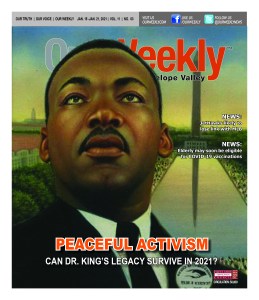
Here and now, more than 50 years after America’s proponent of peace was shot down, Martin Luther King’s bequest remains firmly in place while the war drums of intolerance rage around the world, especially in the country he was born and bred in.
The hue and cry to verify the latest Presidential election results (and the gathering of American lawmakers to undertake their due diligence) prompted another group (bonded by mutual feelings of oppression) to “seize the day,” and storm the grounds of the U.S. Capitol on Jan. 6.
The Capitol building has an interesting, Afro-centric history behind it. Like much of our nation’s capital, it’s construction was largely the result of Black labor including a little known (enslaved) sculptor’s apprentice Phillip Reed, who completed the casting of the 19 foot bronze “Statue of Freedom” which sits atop the dome of the building.
During the Civil War, Washington, D.C. was nestled between the Confederate enclaves of Maryland and Virginia (and 95 miles from the Rebel capital of Richmond). But aside from an audacious (but futile) charge by Gen. Jubal Early in 1864, the southern upstarts never came near it. Last week’s breach of the Capitol building security is thus significant for another reason: It is the first time the Confederate battle flag (alternately known as the stars and bars) has appeared in the nation’s legislative hub.
These events invited comparison to another march/protest by others on the opposite end of the political spectrum, Black Lives Matter (BLM). Enraged by the (lack of) response to the killing of George Floyd by police, scores of protests were held across the country, most tellingly, one on June 2, 2020 in Washington, D.C. (this time at the Lincoln Memorial).
In that event, police used tear gas and rubber bullets to clear crowds in preparation for President Donald J. Trump’s photo opportunity in front of St. John’s Episcopal Church.
In the words of BLM founder Melina Abdullah, a professor at Cal State Los Angeles, Trump then “sicced” the police (and over 4,000 members of the National Guard) on the nonviolent demonstrators.
In the aftermath of last Wednesday’s installment, scores of news commentators, political pundits, and average Joes (including the President-elect) compared and contrasted the two scenarios to underscore the hypocrisy of the law enforcement and justice systems.
Politics ‘post Trump’ leaves many unanswered questions
By Merdies Hayes
Jan. 29
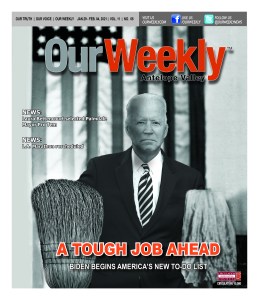
Donald Trump left office a week ago. The prevailing question among the voting public is likely “What will post-Trump politics look like?”
President Joe Biden believes it is a time of healing. He’s generally known for conciliation. Yet, 70 million Americans voted for Trump and it is questionable whether these persons will be persuaded toward more centrist policies on Capitol Hill.
By and large, Republicans are hardcore one-issue voters, starting with abortion, low taxes, limited government and law-and-order. Any one of these issues is a motivating factor among the GOP voting block. Republicans have been building this base since at least the 1960s, when Richard Nixon employed the Southern Strategy to feed off White resentment to the gains of the Civil Rights Movement.
About three decades later, Newt Gingrich introduced hyper-partisanship to the mix as House speaker during the Clinton administration.
Republicans took it from there during Barack Obama’s tenure as president, thus fueling the Tea Party and eventually the unexpected rise of Donald Trump. Trump was the next logical step for Republicans and, with the party establishment’s blessings, he tackled not only the Democrats but long-held democratic norms and institutions.
Biden wants to unify the country—to the extent that’s possible—in suggesting policies that address the legitimate grievances of a wide swath of Americans, left, right and center. As he stated during his campaign, the Biden administration will start with the pandemic, followed by health care, racial reconciliation, and economic inequity and insecurity.
Many political watchers believe the new administration—along with party leaders in the Senate and House—should devote considerable time and attention to rebuilding the more liberal wing of the Democratic party. That means addressing racism, misogyny and law enforcement injustices as these issues have historically plagued communities of color. It also means continuing the grassroots progressive organizations and expanding the party’s base by getting more people off the sidelines and registered to vote.
Remembering the legendary Cicely Tyson
by Lisa Fitch
Feb. 5
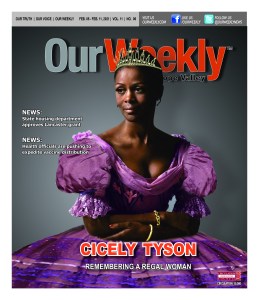
A queen of Black Hollywood, a treasure, a personification of beauty. That’s how some described Cicely Tyson, who died Jan. 28 at the age of 96.
Before leaving, she gave fans a lifetime body of work and inspired the nation in the life she lived. Born in Harlem, N.Y., Tyson decided at an early age to become an actress. She also worked as a fashion model—all much against her mother’s wishes.
“My mother told me that if I was going to do that, I had to leave her house. And so I did,” Tyson said. She then moved in with a friend and borrowed clothes to go on auditions.
“After I moved out, my mother didn’t speak to me for years. She was concerned that I was going to live a life of sin—that’s what she thought show business was all about,” Tyson said. “But I was always determined to prove her wrong. And so my mother became my greatest source of drive in life. I thought, I’ll show her!”
And show her she did.
Tyson worked as a model but later attended the Actors Studio and began her career on stage. She made small appearances in several films in the late 1950s, including Sidney Poitier’s “Odds Against Tomorrow,” before becoming a television regular in the 1960s, with appearances in shows such as “East Side/West Side,” “I Spy,” “The F.B.I.,” “The Courtship of Eddie’s Father” and “Medical Center.”
Early in her career, Tyson decided to never take roles that reflected badly on African-American people. She turned down roles for prostitutes and other parts, preferring to give the world other ground-breaking, memorable roles.
In 1963, Tyson became one of the first African-American actors to co-star in a network television series when she appeared as a regular with George C. Scott in the critically acclaimed, “East Side, West Side,” a gritty program about New York social workers.
After several small television appearances, the turning point in her career came in 1972 when she played Rebecca Morgan, a woman holding her household together during the Great Depression while her husband was in jail for stealing food for the family. Her performance in the movie, “Sounder,” earned her an Academy Award nomination as well as a Golden Globe nomination for Best Actress in a Motion Picture.
In 1974, she won two Emmys; both for “The Autobiography of Miss Jane Pittman.” One for Outstanding Lead Actress, Mini-Series or Drama; and a special Emmy for Actress of the Year. She also portrayed Coretta Scott King in “King: The Martin Luther King Story” and Harriet Tubman in “A Woman Called Moses.”
She won another Emmy in 1994 for her supporting role in “The Oldest Living Confederate Widow Tells It All.”
But Tyson also sought to give back to her community. When Martin Luther King Jr. was killed in 1968, she received a call from her friend Arthur Mitchell, the first African-American principal dancer in the New York City Ballet. Mitchell wanted to do something in King’s honor, and together, the friends decided to found the Dance Theater of Harlem.
Her next notable, Emmy-nominated role was as Kunta Kinte’s mother, Binta, in the 1977 historic mini-series “Roots.” In tribute, Levar Burton who played her son, the young Kunta Kinte, called Tyson “Quite simply one the most beautiful and talented women of her generation.”
“Elegance, style and natural grace oozed effortlessly from every pore of her being, but the word that describes her best in my mind is, regal,” he added.
Homeless in LA County at tipping point of survival
Feb. 25
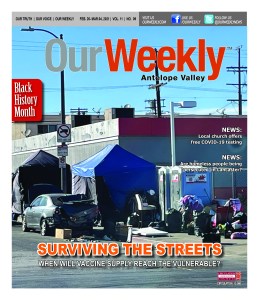
It’s not often that a federal judge steps from behind the bench and—though briefly—sets aside his/her judicial objectivity.
That’s what happened last month as U.S. District Judge David Carter called out local officials in pointing to an “apparent abdication of responsibility” in addressing the worsening conditions along Skid Row in Downtown Los Angeles.
Carter is overseeing a federal civil lawsuit filed by the LA Alliance for Human Rights seeking to compel both the City and County of Los Angeles to get a grip on and inform the citizens of their immediate plans to get these persons off the streets and into any and all forms of temporary housing.
Carter labeled Skid Row as a “significant natural disaster in Southern California with no end in sight.” He recalled surveying the area not long ago after a recent storm and saw hundreds of poorly-clothed persons wet and shivering, coughing and wheezing. One woman was naked and looked as though she wouldn’t last the night.
Carter wants to know whether the policies with regard to Skid Row were “intended” to make the area a “gathering place—voluntary or involuntary—for racial minorities.” In essence, his request that city officials produce any materials where race has been discussed or considered poses the very difficult suggestion that the filth, squalor and desolation that marks Skid Row is a deliberate plan to deposit and omit from memory thousands of African-Americans who have lost their way.
For most of the approximate 67,000 homeless persons in Los Angeles County, their unsightly plight is a year-round predicament with no easy answers forthcoming.
The pandemic compounds their difficult life.
When the coronavirus emerged in the United States last year, public health officials and advocates for the homeless feared the virus would rip through shelters and tent encampments, ravaging vulnerable people who often have chronic health issues. In March 2020, some shelters saw large COVID-19 outbreaks, but the virus didn’t appear to bring about the devastation many had feared.
Researchers nationwide feared this population would succumb in high numbers to the worst face of the disease. At the time, some shelters had outbreaks, but most of those infected showed no symptoms. At the beginning of the pandemic, health professionals knew that living outside normally “weathers” homeless people, teeing them up for a host of diseases and early death.
The Centers for Disease Control and Prevention CDC) suggested that “outside is safer than indoors” because fresh air disperses droplets containing the virus—and there’s more room to keep people apart. One year later, many scientists dispute that assumption as the so-called “resiliency” of homeless people is not as strong as earlier believed.
CLASS Coalition seeking educational equity as LAUSD schools reopen
by Merdies Hayes
April 9

In response to the shifting plans for a return to in-person learning set forth by the Los Angeles Unified School District (LAUSD), the Communities for Los Angeles Student Success (CLASS) Coalition has issued an open letter urging LAUSD to center the voices of low-income students of color and their families in reopening, in order to ensure equity as plans take shape for Spring 2021 and beyond.
The letter further urges LAUSD to prioritize equity in all elements of the reopening process including using the Student Equity Need Index (SENI) to allocate new state and federal funds to the highest-needs schools, by using all available resources (including the assistance of the coalition itself) to reach the thousands of “missing students” who come disproportionately from BIPOC (Black, Indigenous and people of color) communities.
“The pandemic badly widened the longstanding gaps in equity that disproportionately impact our Black and Brown students, but we have a better chance to close those gaps meaningfully than ever before,” said Norma Rodriguez, director of Education Programs & Policy, United Way of Greater Los Angeles. “The CLASS Coalition offers expertise and engagement with populations who experienced the lion’s share of the health and economic trauma brought on by the pandemic. The interest of our most vulnerable students should be at the forefront of decisions made by the school board as LAUSD returns to in-person learning.”
“COVID hit our communities hard,” said Isabel Martinez, Promesa Boyle Heights parent leader. “Every single student and everyone who helps them succeed, from janitors, to teachers, to caregivers, must be included in conversations and decisions if we’re going to make our schools safe. As a mother of an incoming High School freshman, I’m weighing my fear of the unknown against my hope that working together, we will provide students with the adequate resources to succeed.”
“We don’t want to go back to normal, because we have seen that normal wasn’t working,” said Azucena Hernandez, Promesa Boyle Heights, co-director of community transformation. “Promesa Boyle Heights stands with parents, teachers and students as they navigate school reopening and continued virtual learning. As part of the CLASS Coalition, we urge LAUSD to center the voices of those most impacted at the forefront for short- and long-term learning recovery plans. Let’s take into account the social-emotional needs of students and their families by hearing directly from them what quality learning and trauma informed care looks like, and let’s make restorative and equitable changes to move towards healing and innovative recovery as a school district.”
“This is a missed opportunity to ensure that our students—especially the thousands who have not been engaging during distance learning—can be supported to recover from the lost time,” said Educators for Excellence-Los Angeles member Marisa Crabtree, a high school English teacher.
Black guitarists laid foundation for today’s musical inspiration
June 18
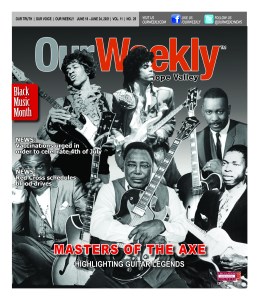
Throughout the history of popular music, the electric guitar is arguably the most familiar and enduring of instruments that has at once warmed our hearts and expanded our horizons. Over the years, a number of African-Americans would comprise a select cadre of some of the greatest musicians to showcase this six-string and 12-string wonder to the world.
B.B. King was widely recognized as the greatest blues guitarist of all time. The title derives not only from his mastery of the guitar, but from the generosity of spirit he brought to the blues.
At a time when the sales of blues records began to wane because of the popularity of Motown and Stax records—and also the British Invasion—King helped to popularize the blues with rock audiences. During the late ‘60s King would perform with rock artists like Jimi Hendrix, Jeff Beck and Eric Clapton, the latter of whom has cited King as a crucial influence on his career.
King was influenced by the early blues recordings of Robert Johnson, Blind Lemon Jefferson and King’s admitted favorite, Sonny Boy Williamson, whom he once said was instrumental to his learning to play the guitar. King won a 1984 Grammy for Best Traditional Blues Recording for “Blues ‘n’ Jazz;” a Grammy Lifetime Achievement Award in 1988; induction into the Rock ‘n Roll Hall of Fame in 1992; a Presidential Medal of Freedom Award from President George W. Bush in 2006; and a star on the Hollywood Walk of Fame.
Aaron Thibeaux Walker was an American composer, musician and blues guitarist known for his “lightning-fast” finger work. He was the earliest pioneer of both electric blues and jump blues type of music. Walker was placed at number 67 by Rolling Stone magazine on its list of “the 100 Greatest Guitarists of All Time” in 2011.
In 1929, Walker released his recording debut with Columbia Records under the name Oak Cliff T-Bone. He released two singles titled “Wichita Falls” and “Trinity River Blues.” In his mid-20s he started working in several clubs along Central Avenue in South Los Angeles together with Les Hite’s orchestra.
T-Bone Walker was inducted into the Blues Hall of Fame in 1980 and entered the Rock ‘n Roll Hall of Fame in 1987.
Prince Rogers Nelson was the natural culmination of many of the aforementioned artists. He achieved worldwide fame in the 1980s with the album soundtrack “Purple Rain” which won an Academy Award for Best Original Song Score.
He would release the popular albums “1999” “Diamonds and Pearls,” “Around The World in a Daze,” “The Gold Experience” and “Musicology” all of which reached platinum status. Another child prodigy, Prince taught himself to play the piano, guitar and drums—and an additional 24 instruments ranging from the accordion to the xylophone.
Among the numerous awards Prince received were a 2007 Golden Globe Award for Best Original Song (“Happy Feet”); BET Lifetime Achievement Award (2010); NAACP Image Award (2005); and the American Music Award of Achievement (1995 and 1996).
Prostate cancer strikes down Black men at startling rates
by Merdies Hayes
July 2
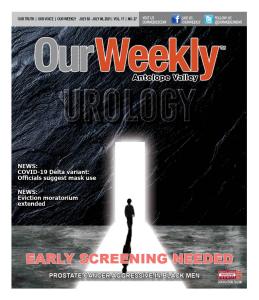
For African-American men, the risk of dying from low-grade prostate cancer is double that of White men.
The new findings come from a study conducted by the National Cancer Institute (NCI) which revealed that doctors may be “underestimating the risk” of death from low-grade prostate cancer in Black men. This finding, recently discussed during a June Men’s Health Month event, has proven to be consistent with other reports that have identified racial differences in the biology and presentation of the disease.
A growing body of evidence tends to support the idea that certain biological factors may make low-grade prostate cancer more likely to grow and spread in Black men than in men of other races. The NCI study analyzed data from the institute’s Surveillance, Epidemiology and End Results program. A special database contained information on more than 190,000 men with prostate cancer who underwent active surveillance (or watchful waiting) between 2011 and 2016.
Patients were followed for a median of three years. During the process, researchers looked at socioeconomic status—a measurement of a person’s income, education, and occupation. Socioeconomic differences, they reported, can lead to health disparities such as less access to treatment.
They also looked at tumor genomics as a possible variable in biological differences (i.e. the features of prostate tumors). More Black men with low-grade prostate cancer had tumor genomic characteristics linked to metastasis (the spread or transfer of any disease, especially cancer) than White men. Characteristics were higher in African-Americans, suggesting that differences in tumor genomics may make low-grade prostate cancer more aggressive in Black men.
“We must reach these patients long before they reach the late stage of the disease,” said Dr. Dana Richardson-Heron, chief patient officer with Pfizer. “It is a similar story among African-Americans with health maladies; the lack of access to quality health care results in many people waiting too long to be diagnosed. Physicians must meet patients ‘where they are’ to better serve their needs. This can help establish a pathway to health equity.”
The prostate is part of the male reproductive system. It is a small gland that sits directly below the bladder. It plays a role in hormone and semen production and helps to manage urine flow. Prostate cancer occurs when cells in the prostate grow out of control. This happens when there are changes in the DNA of prostate cells. Some potential causes of prostate cancer included inherited genes that increase the risk of developing cancer, and acquired mutations from exposure to toxic chemicals.
Prostate cancer can remain symptomless for a long time. Richardson-Heron said people need to educate themselves about the risks and have regular screenings with a doctor. Clinical trials are a great way to determine who may be at greater risk of prostate cancer, but gaining access to these studies isn’t always easy.
America’s sharp rise in crime tied to pandemic, protest movement
By Merdies Hayes
July 30

Mounting concern over crime has reportedly reached the highest level in four years amid an increase in homicides and a general spike in violent crime.
President Joe Biden in June laid out an anti-crime strategy in focusing on gun crime as part of an effort to stem the rise in murders. His plan would also allow communities to use coronavirus relief funds to hire more police officers or to engage in other crime prevention methods. Biden admitted, however, that “there is no one…answer that fits everything.”
The new plan has placed the White House at the forefront of a delicate issue that has at times frustrated lawmakers — notably the Democratic Party — in the past and still carries with it political consequences for the future. Last month, bipartisan congressional negotiators conceded that an agreement on police reform legislation remained elusive after about four months of discussion. Looming midterm elections may threaten to make progress in this issue even more contentious.
Some crimes, mostly shootings and homicides, are up in many cities. However, this surge may represent a very small percentage of violent crime and an even smaller part of total crime. Richard Rosenfeld, a criminologist and professor at the University of Missouri-St. Louis, has suggested that police are frustrated with rising animosity and might be pulling back. As well, some communities may be so distrustful of police that members are taking vigilante justice into their own hands.
“While homicides and shootings have been rising, property crimes and burglaries are down or steady in many cities,” Rosenfeld said. “What we’ve been seeing is just across-the-board increases. We’ve continued to see this — roughly speaking — through the first half of this year. What is not being reported are the large number of cities not showing big increases or indeed actually showing declines over last year.”
Crime is also connected to any economic crisis. The pandemic’s economic consequences — unemployment, housing insecurity, food shortages — may have contributed to rising crime rates. The rise, though, remains significantly lower than the historical peak in crime in the late 1980s and early 1990s.
The protests over police brutality — which essentially began in 2014 in Ferguson, Mo. over the killing of Michael Brown — swept through cities followed by a rise in murder and sometimes other violence. However, criminologists caution that while several sides in the ensuing debate claimed a “Ferguson effect,” there has been little to no empirical research conducted to verify such claims.
Tuesday recall election to determine if Gavin Newsom stays or goes
By Lisa Fitch
September 10

The federal Voting Rights Act of 1965 is under fire, as many African-Americans are being cheated out of their right to vote in Republican-led states. Voting is a basic, American right for which many Black ancestors fought and died.
Supporters of Gov. Gavin Newsom say it is especially important to raise everyone’s voting voices regarding the Tuesday, Sept. 14 election, as conservative Republicans who seek the governor’s recall want to take California in a different direction. Don’t sit out this special election and let others determine California’s future.
Even though Newsom has been a pioneer on same-sex marriage, gun safety, marijuana, the death penalty, universal health care, access to preschool, technology, criminal justice reform, and the minimum wage, and his policies were ultimately, embraced and replicated across the nation, he faces opposition members who want to turn California into a red state.
According to California Black Media, the state currently has the largest economy in the country and a budget surplus of $75.7 billion under Newsom’s leadership.
Additionally, the governor issued the first statewide stay-at-home order in the nation, and his policies kept most public school students at home last year. Newsom has required all health care workers to get fully vaccinated by the end of the month.
“We still have work to do but this is a momentous occasion to be able to announce at a statewide level—a state of 40 million people, a state that has a population of 21 state populations combined—that we have broken now 80 percent of all eligible Californians having received at least one dose,” Newsom said during an appearance in Oakland. “That’s top 10 in the United States.
“… We continue to be mindful of our responsibility to do more and do better, particularly for diverse communities,” he said, noting that the Latino and Black communities still have generally lower vaccination rates across the state.
Newsom noted that the state is working “ to deal with the misinformation and the intentional disinformation” circulating about the vaccines, particularly on social media.
According to the governor, the state’s average rate of people testing positive for the virus has fallen to 4.6 percent, down from 7.1 percent a few weeks ago. He said by comparison, the positivity rate in Florida is 18.7 percent, and in Texas it’s 16 percent.
The governor has said his policies are driven by science, but they have helped land him in an unexpectedly competitive recall election.
California has not elected a Republican governor since Arnold Schwarzenegger won in a 2003 recall election.
Human Rights Day helps define the dignity and worth of everyone
December 9
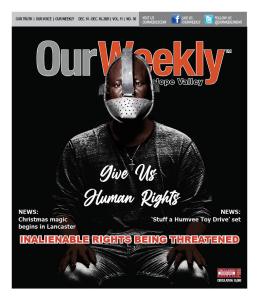
The “Social Contract” of The Enlightenment suggested a new paradigm of freedoms by which modern republics would formulate levels of evidentiary “truths” of independence and self governance. Unfortunately, for at least 250 years, such treatises have often been misused by the powerful to subjugate the weak.
Human Rights Day is observed every year on Dec. 10—the day the United National General Assembly adopted, in 1948, the Universal Declaration of Human Rights (UDHR). It was a milestone document following World War II which proclaims the inalienable rights that everyone is entitled to as a human being—regardless of race, color, religion, sex, language, political or other opinion, national or social origin, property, birth or other status. It is available in more than 500 languages.
This week, the Biden Administration announced a diplomatic boycott of the Beijing Olympics over China’s human rights abuses. China is accused of committing crimes against humanity against the Uyghur (Muslim) population in Xinjiang. The Biden White House and former President Donald Trump’s administration referred to a China’s treatment of Uyghurs—which includes allegaitons of forced mass sterilization, forced labor and separating families—as “genocide.”
There have been growing calls in the United States and across the world to boycott the Olympic Games for numerous reasons, not the least of which is the story of Chinese tennis star Peng Shuai who went missing earlier this year. She alleged that a high-ranking Chinese politician had coerced her into sex. The International Olympics Committee has drawn harsh criticism for its handling of Shuai’s disappearance,while the Women’s Tennis Association has suspended all tournaments in China.
The principals of equality and non-discrimination are at the heart of human rights. Equality is aligned with addressing and finding solutions for deep-rooted forms of discrimination that have affected the most vulnerable people in societies, including women and girls, indigenous peoples, people of African descent, migrants, people with disabilities and the LGBTQ community.
This year’s Human Rights Day theme, “Equality,” relates directly to Article 1 of the original UDHR position that “all human beings are born free and equal in dignity and rights.” A new U.N. approach is set forth in a specific “Shared Framework on Leaving No One Behind: Equality and Non-Discrimination at the Heart ort Sustainable Development.” The document proclaims that equality, inclusion and non-discrimination, in other words—a human rights-based approach to development—is the best way to reduce inequalities and resume a collective path towards realizing its 2030 objective.
Eleanor Roosevelt was a driving force behind the UDHR. At the time, she said of the historic agreement: “Where, after all, do universal human rights begin? In small places, close to home–so close and so small that they cannot be seen on any maps of the world. Unless these rights have meaning there, they have little meaning anywhere. Without concerned citizen action to uphold them close to home, we shall look in vain for progress in the larger world.” Other persons instrumental in the establishment of the UDHR include Dr. Ralph Bunche, Chinese diplomat Peng-chun Chang, and Judge Herman Santa Cruz of Chile.
The “new” social contract through 2030 includes economic, social and cultural rights, as well as the right to development and the right to a safe, clean and sustainable environment. It includes equal opportunities for youth in noting that “unless their rights are protected, including through decent jobs and social protection, the ‘COVID generation’ runs the risk of falling prey to the detrimental effects of mounting inequality and poverty.”
Historic start to the Biden administration
Jan. 21, 2021
BY LISA OLIVIA FITCH
EDITOR IN CHIEF
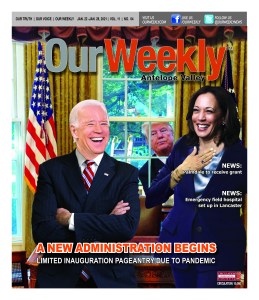
It was a different inauguration, unlike any that has been held in Washington D.C. There were no large crowds on the Capitol Mall, no parade down Constitution Avenue, and no former president to peacefully transition power.
The latter hadn’t happened since Andrew Johnson, another impeached president, decided to boycott the inauguration of Ulysses S. Grant.
Additionally, everyone on the Capitol stage had been tested for the coronavirus twice in those previous 72 hours. Including the supreme court justices, congressional members, three former presidents and their wives.
President Joe Biden, unlike his predecessor, has been in public service most of his life and served as a senator from Delaware for 36 years.
Finally, history was made at the swearing in ceremony of Vice President Kamala Harris, the daughter of immigrants whose mother often told her “Don’t sit around and complain about things. Do something.”
“This is a breaking of a glass ceiling,” one commentator noted.
The theme this year: “America united.”
The Rev. Leo Jeremiah O’Donovan III invoked the wisdom Solomon sought in his opening prayer.
“This is America’s day, this is democracy’s day,” Biden said during his speech. “Americans have been tested anew and America has risen to the challenge. Today we celebrate not the victory of a candidate but the victory of a cause.
“This is a great nation, we’re good people,” Biden continued. “A cry for racial justice some 400 years in the making moves us.”
The president referenced the moment Abraham Lincoln signed the Emancipation Proclamation and told his aides that he believed the document would be his legacy and that his whole soul was in it.
“My whole soul is in it,” Biden said. “My whole soul is in this uniting our nation and I ask every American to join me in this cause. We can do great things, important things.”
Mentioning the deadly coronavirus and the fight for racial justice several times in his remarks the President said “Our history has been a constant struggle between the American ideal that all are created equal, and racism…. that has torn us apart.”
But Biden is hopeful, and noted that Americans will need each other’s strength to make it through. He quoted Psalms 30:5: “Weeping may endure for a night, but joy comes in the morning.’”
# # #
Soldier, Statesman, American
Oct. 21, 2021
BY GREGG REESE
OW CONTRIBUTOR
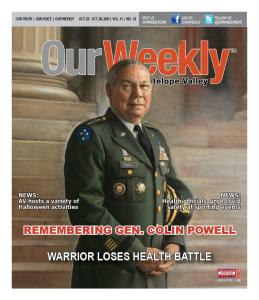
The coronavirus (COVID-19) has taken yet another life, one notable outside the 700,000+ so far. Gen. Colin L. Powell succumbed to complications from the disease on the morning of Oct. 18, his family announced on his Facebook page.
“We have lost a remarkable and loving husband, father, grandfather and a great American,” the statement read.
Powell, who had been treated at Bethesda, Md’s Walter Reed National Medical Center for blood cancer, was 84 years old. He became the first of his race to head up the Joint Chiefs Staff as well as serving as the Secretary of State. He attained these positions through his ability to garner the respect of both the Republican and Democratic sides of America’s political divide.
The soldier and statesman displayed no potential for greatness early on. The offspring of Jamaican immigrants, he was born in April 1937, and grew up in the New York borough of the South Bronx.
Colin demonstrated no exceptional skill academically or athletically until he enrolled at the City College of New York (CCNY), where he pledged a campus ROTC society, and discovered a knack for military drill and ceremony. The structure and regimentation awakened something within the aspiring soldier, and in short order after receiving his degree in geology in 1958, he was commissioned as a second lieutenant in the U.S. Army.
Postings in Germany, then at Ft. Devens, Mass., were significant because he received his first company commands. More tellingly, a blind date yielded an introduction to a well-bred southern belle from one of the leading Negro families in Birmingham, Ala.
Alma Johnson was a Fisk University graduate who’d come to Boston for training in audiology while moonlighting as a radio show host. In short order, the new couple became inseparable, engaged, and were wed in August of 1962, less than a year after meeting the previous November.
Now a Captain, Powell won a Bronze Star and a Purple Heart for wounds sustained in Vietnam combat. Upon his return to the States, he went on to success in civilian life as a lawyer and as head of the Federal Communications Commission.
A second tour as a major was highlighted by his heading up the inquiry into the infamous My Lai massacre. Once back home, Powell was fortuitously endowed with career-building perks in the form of graduate school, and a White House Fellowship.
Now a Lt. Colonel, Powell was ordered to South Korea in 1973, where he took command of a battalion near that country’s Demilitarized Zone.
By the 1980s, Colin Powell was a Brigadier General. A second star meant ascension to the office of Secretary of Defense Casper Weinberger, as his senior military assistant in planning the 1983 invasion of Grenada.
Powell was embraced by the Ronald Reagan Presidency as its National Security Advisor (retaining his three star rank as a Lt. General), the first African-American in that posting. Two years later in 1989, he was awarded a fourth and final star.
Now the Chairman of the Joint Chiefs of Staff, Four Star Gen. Powell burst into the public limelight as the architect of 1991’s Desert Storm, an operation to counter Iraqi strongman Saddam Hussein’s invasion of oil-rich Kuwait.
The whole campaign was over in 42 days. Powell and his field commander, Gen. “Stormin’”Norman Schwarzkopf became household names.
After his 1993 retirement, Powell maintained a limited commitment to public life until 2000, when President George W. Bush pegged him as Secretary of State, the first Black man so honored.
When pressed about his political affiliation, he diplomatically evaded the question for years before embracing the GOP. As time went on, he embraced the party line, which may explain his most memorable misstep — his presentation before the United Nations Security Council indicated that Iraq possessed the means to make Weapons of Mass Destruction (WMDs). Later, these claims were proven false, and Powell resigned in November of 2004.
He continued his moderate stance after his retirement, crossing the political line to endorse Barack Obama and Hillary Clinton for the Presidency.
Following January’s deadly insurrection at the U.S. Capitol building, Powell said he no longer considered himself a Republican and admonished the party for putting political interests ahead of the interests of Americans.
Lifestyle changes can help prevent development of diabetes
By Lisa Fitch
Nov. 4
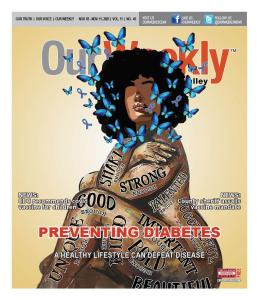
Nearly 15 percent of Black Americans have diabetes compared to 8 percent of White Americans. According to the American Heart Association, in 2018, diabetes caused the deaths of more than 15,000 African-Americans. But this is a condition that can be managed. By living a healthy lifestyle filled with exercise and proper diet, one can live a normal life and do everything they set out to do.
The California Black Health Network (CBHN) kicked off National Diabetes Month and its Health4Life series with a live cooking demonstration Oct. 28. Health4Life is a health and wellness education initiative designed to help Black Californians become more empowered to take charge of their health and wellness.
“This is actually the way we all should be eating,” said Chef Tiffany Derry, who led a step-by-step demonstration on how to make simple and satisfying dishes that keep the “flavor” in meals while also keeping them healthy and nutritious. “What we should be doing is reducing carbs, salt, sugar and fat.”
Recipe cards for the chicken curry and banana nice cream Derry created during the webinar are featured on https://www.cablackhealthnetwork.org/events/ . Derry is best known as a fan-favorite on Bravo TV’s “Top Chef.” She is also a Novo Nordisk Diabetes Ambassador for healthy cooking demonstrations and educational workshops. Derry found a love of cooking at an early age and later graduated from The Art Institute of Houston, Texas.
“I actually believe that if you eat better, then you feel better,” she said.
Derry explained that everyone should assess every plate that is eaten. For example, half of the dinner plate should feature a non-starchy vegetable, while the remaining half should be divided between the protein and starch segments of a meal. It is also good, she said, to make a journal to note everything one eats each day. Portion size and colorful meals are important when cooking.
“Maybe the size of the palm of your hand can be a portion,” Derry said, “And ‘taste the rainbow’ —I like that saying,”
She noted that her Dallas restaurants mostly serve southern cuisine.
“Sometimes people think you need to sacrifice flavor to have something delicious,” Derry said during her demonstration. “I don’t play around with things that don’t taste delicious.”
Derry’s family had a farm, where they used to shell peas and eat greens. She recommends everyone to eat more vegetables and use a few herbs spices to create different flavors
“One key ingredient we haven’t talked about is acid.” Derry said. “Lemon, lime, vinegar—it really picks up a dish. One of the tricks that we do is ladd a little bit of acid. Sometimes it can mimic some salt.”
Additional recipes can be found on diabetesfoodhub.org.
Early detection and treatment of diabetes can decrease the risk of developing the complications of diabetes. Although some people with diabetes have symptoms so mild that they go unnoticed, common symptoms of diabetes include: Urinating often; feeling very thirsty; feeling very hungry—even though you are eating; extreme fatigue; blurry vision; cuts/bruises that are slow to heal; weight loss—even though you are eating more (type 1); tingling, pain, or numbness in the hands/feet (type 2).
The human body breaks down food carbohydrates into blood sugar (blood glucose) that it uses for energy, and insulin is a hormone that the body needs to get glucose from the bloodstream into the cells of the body.
In type 1 diabetes, the body does not produce insulin. With the help of insulin therapy and other treatments, everyone can learn to manage their condition and live long, healthy lives.
Type 2 diabetes is the most common form of diabetes—and it means that the body doesn’t use insulin properly. And while some people can control their blood sugar levels with healthy eating and exercise, others may need medication or insulin to help manage it. Regardless, there are options—and health professionals are available with needed tools, resources and support.
A large body of research suggests that smoking is strongly “associated” with the development of type 2 diabetes. A review of 25 studies found that smokers are 44 percent more likely to develop type 2 diabetes, and heavy smokers are 61 percent more likely than non-smokers to develop type 2 diabetes.
Smoking or using any other type of tobacco raises blood sugar, which is thought to result in insulin resistance. Smoking can also cause complications to those who have diabetes. It increases the risk of heart attacks and strokes; blood pressure; cholesterol; damages blood vessels and prevents their proper healing; increases the risk of gingivitis and periodontal disease; increases the risk of kidney disease; increases the risk of cancer; increases the risk of erectile dysfunction; and increases the risk of lung problems.
Latest abortion fight renews 50 years of legal wrangling
Nov. 17
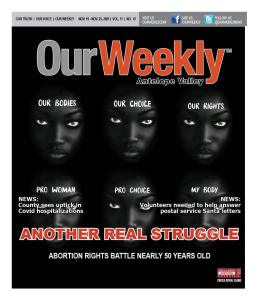
Nearly five decades after the U.S. Supreme Court ruling on Roe v. Wade, opponents and supporters of abortion rights continue a strident battle over the issue in court, at the ballot box and in state legislatures.
Several states have introduced or passed new restrictions on abortion with an eye toward giving the Supreme Court new rationale to overturn the landmark—and divisive—1973 decision.
Supporters of Roe specifically want the high court to review a Mississippi law that aims to make most abortions after 15 weeks of pregnancy illegal. They also want to strike down the Texas “heartbeat bill’ that bans abortions after six weeks into pregnancy…far before most women know they’re pregnant.
As is custom, the Pew Research Center this summer conducted its latest poll on the topic and found that around six in 10 adults (59 percent) say that abortion should be legal in all or most cases. Thirty-nine percent say it should be illegal in all or most cases.
The partisan gap is as wide as it has ever been. Democrats and “democrat-lean” independents are much more likely than Republicans or “republican-lean” independents to say that abortion should be legal in all or most cases today (80 percent vs. 35 percent). This 45-percentage point gap is up from the 33-point gap in 2016 when 72 percent of democrats and 39 percent of republicans supported legal abortion in all or most cases.
Depending on what religion you practice, opinions about abortion vary widely. About three-quarters of White evangelical Protestants (77 percent) say it should be illegal in all or most cases. Twenty-one percent of these persons say it should be legal in most instances. By comparison, a 63-percent majority of White Protestants who are not evangelical say abortion should be legal in all or most cases.
Regardless of what the political party stance is on abortion, voters don’t always agree with the dominant position or with the party they identify with or lean toward. About one-third of Republicans or GOP “leaners” said they did not agree with their party on abortion (35 percent). Among democrats and those who may lean toward that party, 29 percent did not agree with their party on abortion, including 7 percent who said they agreed with the GOP and 22 percent who said they didn’t agree with either party.
Democrats are far more likely than Republicans to see Roe v. Wade stand.
Republicans, according to the poll, are somewhat evenly divided with 50 percent saying they would not want to see Roe v. Wade completely overturned, and 48 percent saying they would.
The Supreme Court will take up the case on Dec. 1 in what may be the Pro Life movement’s best opportunity to overturn Roe v. Wade. CNN took a poll last summer revealing that most people had no interest in dismantling Roe. Only a scant 20 to 30 percent believed the statute should be overturned. Almost half, the survey found, would like the Supreme Court to make it easier to obtain an abortion. Thirty-five percent said the high court should make it harder to do so.
The Texas bill has drawn sharp criticism from Pro-Choice advocates because it effectively “deputizes” citizens to turn in abortion providers—and those who in any way assists a woman in seeking an abortion—for a bounty of $10,000. A handful of other states are gathering their resources to craft bills similar to those passed in Texas and in Mississippi.









